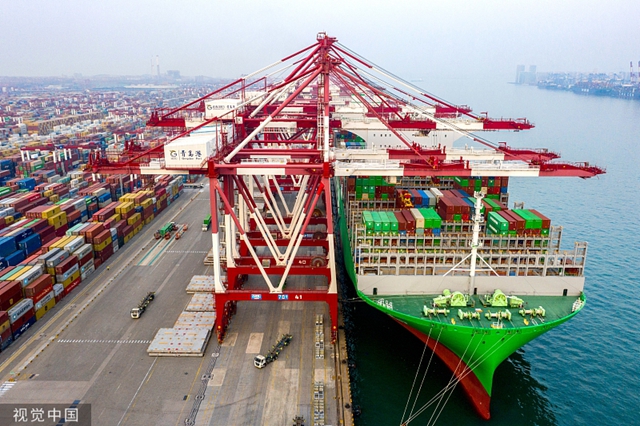
Qingdao Port, Shandong province [Photo/VCG]
According to the latest forecasts from the International Monetary Fund and the World Trade Organization, a slowdown in the global economy and trade is probable this year.
Weak international market demand is expected to pose a challenge to China's foreign trade. In order to continuously drive imports and exports as a key pillar of economic growth, this year's Government Work Report highlighted the importance of steady increases in both the volume and quality of imports and exports, as well as a basic equilibrium in the balance of payments.
The volume of trade in goods exceeded expectations, with utilized foreign investment increasing steadily last year. China's official figures show that China-United States trade volume totaled $759.31 billion (up 0.58 percent) in 2022, comprising $581.61 billion of exports to the United States (up 1.1 percent) and $177.70 billion of imports from the US(down 1.1 percent).
Both the total volume of China-US trade and China's exports to the US hit record highs.
According to US data, US trade with China amounted to $690.59 billion (up 5.2 percent), with $153.84 billion of US exports to China (up 1.6 percent) and $536.75 billion of US imports from China (up 6.3 percent). All three readings broke records and showed that the Sino-US economic and trade relations are highly complementary and resilient.
The figures are also clear evidence of the enormous potential and complementarity of the bilateral economic and trade relations between China and the US, and show that the mutually beneficial and win-win nature of bilateral economic and trade cooperation should be given full play.
The quality and structure of China's trade with major economies is critical for its growth. But as well as continuing to enhance the level of its trade cooperation with major economies including the US, the European Union, Japan and the Republic of Korea, China will press ahead with greater efforts to explore emerging markets and strengthen its trade with Latin American countries and countries involved in the Belt and Road Initiative. In addition, China will continue to develop new foreign trade products and refresh business forms and patterns, to further improve the quality and efficiency of its foreign trade so as to maintain strong momentum for sustained development.
China's foreign trade has proved incredibly resilient, which enables it to adjust and adapt quickly in the face of external impacts and internal adjustments, while maintaining stability and sustainability. The reasons for this resilience are multifaceted: China's long-term economic outlook, which is the very foundation on which foreign trade is built, remains positive, and its foreign trade benefits from the country's strong industrial base, the advantage of its huge market, its diversified trade partners, flourishing new trade forms, abundant trade subjects and effective policy support.
Take, for example, how industry supports the country's foreign trade development: China has 41 industrial divisions, 207 industrial groups and 666 industrial classes, making it the only country that has presence in all industrial sections listed in the International Standard Industrial Classification of All Economic Activities of the United Nations. In 2022, the total value added of the industrial sector in China exceeded 40 trillion yuan ($5.8 trillion). Notably, the value added of the manufacturing industry made up 27.7 percent of GDP, and the scale of manufacturing in China has ranked first globally for 13 consecutive years. The healthy and rapid development of the manufacturing industry will support China's transformation from "the world's factory" to "the world's market", and will also inject momentum into global trade.
Looking ahead, China will take multipronged measures to promote a higher level of openness and drive the steady development of foreign trade. The central government will seek to provide a favorable environment for foreign trade by advancing efforts to join high-standard economic and trade pacts such as the Comprehensive and Progressive Agreement for Trans-Pacific Partnership and the Digital Economy Partnership Agreement, as well as by deepening the reform of domestic trade liberalization and facilitation in alignment with relevant rules, regulations, management and standards. It will strive to diversify its foreign trade markets by expanding the high-standard free trade agreement network that is open to the whole world, proactively developing global partnerships and forging equal and mutually beneficial cooperation with countries around the globe.
The central government will also continue to adhere to the basic State policy of opening-up and pursue an open strategy of mutual benefit and win-win cooperation, so as to make a greater contribution to the development of global trade.
The author is president of the Chinese Academy of International Trade and Economic Cooperation of the Ministry of Commerce of China. The views do not necessarily reflect those of China Daily.